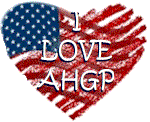Historic Fort Washington on the Potomac
By James Dudley Morgan, M.D. (Read before
the Society, January 12, 1903.)
The strategic
advantage of that promontory on the Potomac, which is now called
Fort Washington, seems to have been known to the Indians, long
before the coming of the white man into this region. That these
aborigines appreciated the natural advantages for defense and
offense offered by this bluff at the junction of the Potomac
River and Piscataway Creek, and that their judgment and choice
of the situation were both sound and unassailable is attested by
the continued occupancy of this mound for hostile defense by the
first colonial settlers under Governor Calvert; by its choice as
a point for a fortification by Generals Washington and Knox; by
its improvement and enlargement under Presidents Madison and
Monroe, and by its reaching at our present day the distinction
of flying the garrison flag.
First Period
The colonists
from England, in the Ark and the Dove, penetrated as far up the
Potomac River as what is now called Heron and Black stone
Islands, before disembarking. Leaving most of his party here.
Governor Leonard Calvert, with a few chosen men of the party,
set out in two pinnaces to further explore the river. They made
several landings, one about four leagues up at a point near the
present Colonial Beach, but here the natives on their approach
became alarmed and fled into the interior. Their next stop was
after sailing about nine leagues, which brought them to what is
now called Marlborough Point.1 Here
the Indian chief, Archihu, met them in a friendly manner and
said, "You are welcome; we will use one table; my people shall
hunt for my brother." Continuing their voyage of discovery, they
came to what was then and is yet called Piscataway Creek, and
here they found the surrounding heights covered with Indians, to
the number of about five hundred, in hostile array. After long
and patient gesticulations and demonstrations, the colonists
convinced the natives that their mission was peaceable, and a
conference with their chief then took place. It was here that
the English found Henry Fleet, who had been captured and held as
a prisoner, and through his acting as interpreter much good
feeling was shown.
Shortly after the arrival of Governor
Calvert and his party at Piscataway Creek the Indian chief fell
ill, and forty conjurers or medicine men in vain tried every
remedy within their power; when one of Governor Calvert's party,
a Father White, by permission of the chief administered some
medicine to him and caused him to be freely bled; the treatment
was successful, the invalid began to improve, and was soon
restored to perfect health.2 The
chieftain, though, would not bid Calvert and his men either go
or stay, but told him "he might use his own discretion.
''Governor Calvert, not over pleased with the dubiousness of his
welcome, thought prudence was the better policy, and deeming it
unwise to settle so far up (150 miles) the Potomac, after having
by various presents persuaded the chief of the Piscataways to
allow Henry
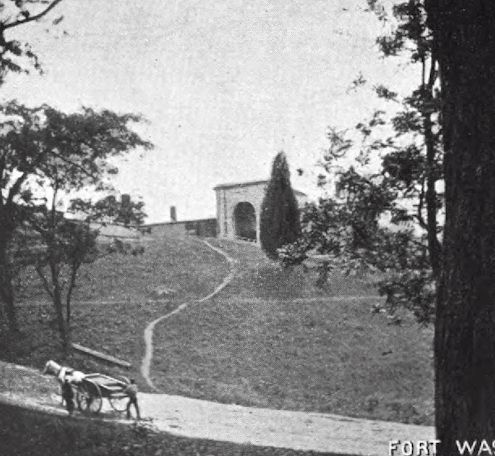
Fort Washington
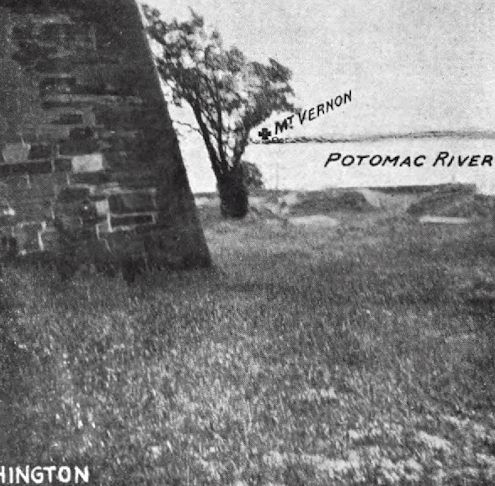
Mt. Vernon
Fleet to
accompany them, returned for his copatriots, who were awaiting
him at Blackistone's Island, and entering the river now called
the St. Mary's, and about ten miles from its junction with the
Potomac, purchased of the Indians part of their village, where
he commenced his settlement to which was given the name (March
27, 1634) of St. Mary's. This purchase of land and treaty with
the Indians was much facilitated by a happy occurrence, at least
for the colonists, which took place at this time. The
Susquehannock Indians, who lived about the head of the bay, were
in the practice of making incursions on their neighbors, the
Yoamacoes, in the vicinity of St. Mary's city, partly for
dominion and partly for booty, and of the booty women were
mostly desired. The Yoamacoes were at this very time fearing a
visitation of the Susquehannocks, and had already gotten to a
point of safety many of their wives and sweethearts, so that
striking a bargain for the purchase of the land was rendered
very easy for the colonists.
It was but
eleven years after (1645) the establishment of St. Mary's city
(1634) that among the many acts and regulations for the defense
of the province, we read of one for the establishment of a
garrison at the mouth of the Piscataway Creek, and authorizing
"Thomas Watson of St. George's Hundred to assemble all the
freemen of that hundred for the purpose of assessing upon that
hundred only the charge of a soldier, who had been sent by that
hundred to serve in the garrison at Piscataway."3
In Ridpath's "History of the United States," page 219, we read
as follows: "On the present site of Fort Washington, which is
nearly opposite Mount Vernon, the Indian village of Piscataway
stood. Here Gov. Leonard Calvert moored his pinnace and held a
conference with the chief of the Piscataways." "This Indian
village," says Willson, in his history, "was fifteen miles south
from Washington on the east side of the Potomac at the mouth of
the Piscataway Creek, opposite Mount Vernon and near the site of
the present Fort Washington." An Indian settlement appears on
John Smith's map of Virginia, opposite Mount Vernon, at the
mouth of the Piscataway Creek.
Second Period
It is always
a subject for congratulation that any enterprise in connection
with the interests of our young republic was either instigated
by or had the endorsement of General Washington. He evidently
weighed well and considered and overlooked the whole field of
facts before promoting or sanctioning an innovation. That he
might gain a more thorough knowledge of the topography of the
country surrounding our Federal City, and the course and
tributaries of the Potomac he, in 1785, accompanied by several
friends, among whom was Governor Johnson of Maryland, made a
tour of investigation, in a canoe, of the upper Potomac, long
before the removal of the seat of government to Washington. So
it was before recommending to General Knox that promontory on
the Potomac for a fort (1794)4 that
he had overlooked, examined and sojourned in the immediate
neighbor-hood and consequently was thoroughly familiar with the
locality and knew of its many advantages. It was often his
custom in going either to Bladensburg, Upper Marlborough or to
Annapolis to ferry the Potomac from Mount Vernon to Warburton,
and thus continue his journey. He has often, when tired or
belated, or for social intercourse, stopped and spent some time
with George or Thomas Digges at Warburton what is now Fort
Washington. The writer has heard Dr. Joseph M. Toner, in
speaking of the beautiful and unobstructed view from Mount
Vernon to Warburton5 (now Fort
Washington), narrate the story taken from Washington Irving's
"Life of General Washington," of how General Washington stood on
that knoll, a little to the front of his home, and through that
forest vista signaled by flag to Warburton. Then their little
boats with liveried men would pull out from the shores of the
Potomac, to bear the invited one to Mount Vernon or Warburton,
or to strike a trade perchance of tobacco, corn, or wheat, for
cattle or sheep, or what not.
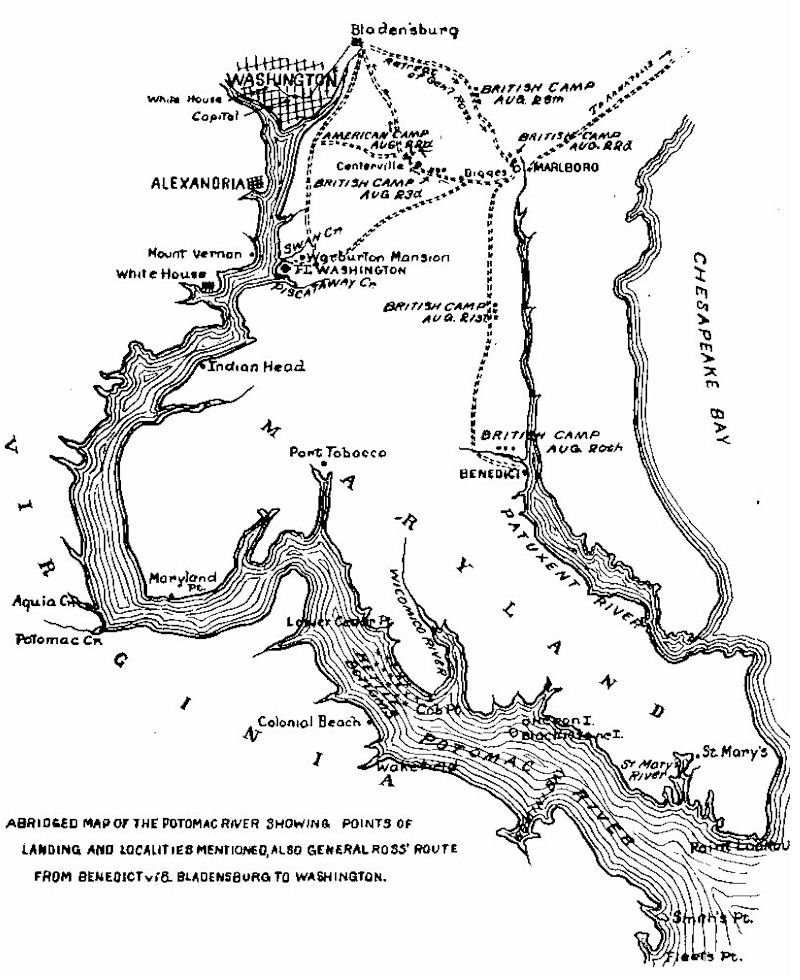
From Old Maps of the Potomac
River and its Environments, by Dr. James D. Morgan
Exhibit 1
Warburton April 7, 1775.
Dear Sir
My Father & Mr. Hawkins will take four, hundred Bushel
of your Salt, & I will copy a few Advertisements to be
put up in this Neighborhood, your Vessel may come along
side of our Warf, which I apprehend would be more
Convenient for the people that may want to purchase.
"At Fort Washington, now Fort Warburton." "In August,
1814, the troops stationed at Fort Warburton, the only
defense of Alexandria, blew up the magazine, and
abandoned the fort." Pages 15 and 128, "Description of
the Territory of Columbia," Warden, Paris, 1816.
"In the same despondent hour, when General Winder
declared that Fort Warburton was not tenable. * * *
"Historical Sketch of Second War between United States
and Great Britain," by Chas. J. Ingersoll, p. 181, Phila.,
Lea and Blanchard, 1849.
The family Join in Complts to all at Mt. Vernon, with
Dear Sir
Your Most Ob Sert.
Geo Digges
(Addressed to) For Col. George Washington at Mount
Vernon. |
The Manor of
Warburton was patented in October 20, 1641. Bounded by
Piscataway Creek, Potomac River and part of Swan Creek by
natural boundary's, etc., makes it 1,200 acres more or less.
Short entry of the certificate is dated June 20, 1637.
Exhibit 2
(To
Thomas Digges about exchange of wheat, from Gen.
Washington.)
Genl. Washington presents his
compliments to Mr. Digges, and will, with pleasure,
exchange 20 bushels of the early White Wheat with him
when he gets it out of the straw; which is not the case
at present, nor can be until the latter end of next week
or beginning of the week following: which would be full
early for sowing that kind of Wheat. Indeed any time in
September, is in good season. The middle, better than
sooner in that month.
A good journey to Mr. Digges
Mount Vernon 31. Septr. 1799.
|
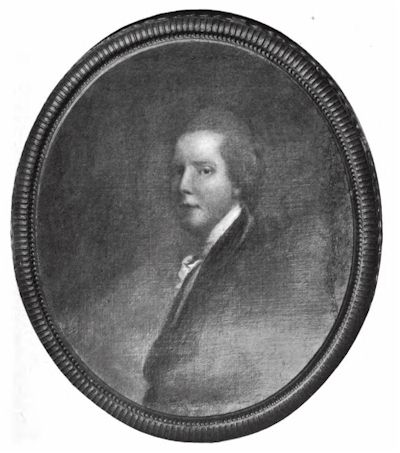
Thomas Digges of Warburton
Manor
From portrait by Sir Joshua Reynolds, in possession of Mrs. Ella
Morgan Speer
There was
evidently much social visiting between the Washingtons and the
families at Warburton and other neighboring country seats. In
addition to the hospitality extended during the hunting season,
Mr. Irving speaks of "water parties upon the Potomac in those
palmy days, when Mr. Digges would receive his guests in a barge
rowed by six Negroes arrayed in the uniform, whose
distinguishing features were checked shirts and black velvet
caps. As Mr. Irving's 'palmy days' were before the Revolution,
the Mr. Digges referred to was evidently Mr. George A. Digges,
who lived at Warburton, until his death in 1792. At this time,
Warburton passed into the hands of a bachelor brother, Thomas.
As was customary with the sons of the Maryland and the Virginia
planters, Thomas Digges had spent his youth in London, where he
was known in his circle of friends as the handsome American.
Although young Digges lived the life of a youth of fashion among
the 'Macaroni' of his day, when his services were needed by his
country, he proved him-self to be a man of resolute character,
and ardently patriotic. The Continental Congress required a
secret and confidential agent near the Court of St. James, and
Thomas Digges was, through the influence of Washington, selected
for this hazardous and important mission.''6
Exhibit 3
(Addressed to)
His Excellency General Washington at Mount Vernon
Virginia.
(Endorsed by Washington)
From Thomas Digges Esq.
10th April 1798.
Mr. Digges presents His respectful compliments and best
wishes to General Washington and sends this in a small
box of seeds, which accompanies a few Potatoes of a
remarkably approved kind & productive Growth, which Mr.
Rhd. Edmonds Seedsman No. 96 Grace Church Street London
handsomely offered to and pressd Mr. D to present in His
name to General Washington.
Mr. Chs. Pye, who has also purchased some seeds of Mr.
Edmonds with me, has promised to take care of them, He
being one of the passengers by the Mount Vernon Capt.
Johnson bound to Alexandria.
The Potatoes and the Garden Seeds are obliged to be put
in separate parcels for fear of the yielding damp of the
former hurtling [sic] the seeds.
Mr. Rhd. Edmond's
No. 96 Grace Church Street
London 10th Apl. 1798.
Mr. Digges has taken the liberty to send in the Box of
Seeds a few late News Papers. |
Exhibit 47
Annapolis
Jany. 5, 1787. Dear Sir
Mr. Gillis's Polk (who is now here) & lives at Salisbury
in Somerset County will Immediately upon his return home
have the plank sawed agreeable to your direction & also
will forward it by the first Opportunity. Our Senate
have rejected the Money Bill & this day we expect a
Message from them given their reasons. We have done
little or no Public Business nor. doe I believe we shall
as there seems to be a Party for breaking up at all
events next Week
with Compts. to Mrs. Washington & family am
Dear Sir with great Respect
Yr. Most Obt. Sert.
Geo. Digges
N. B.
I did not get yr. letter till after the Post left Town &
Mr. Powell the bearer of this has promised to forward it
- To Genl. Washington.) |
Third Period
From the
period of about 1795, when negotiations were entered into with
Mr. George Digges for the purchase of part of Warburton at the
mouth of the Piscataway Creek, on the Potomac River, for a fort,
and the further expense to the government of small sums of money
for entrenchments at that point, there was very little done,
until President Madison, aroused by the imminent danger of war
with Great Britain, directed that Major Pierre Charles L 'Enfant
proceed to Fort Warburton and report to the Secretary of War the
condition of that defense. Major L'Enfant, in a written report
(May 28, 1813), told of the dilapidated condition of the fort
and the armament, and urged a suitable appropriation for putting
the fort in proper condition for the defense of the Potomac and
the Federal City. He spoke of the necessity of an additional
number of heavy guns at Fort Warburton and an additional fort in
the neighborhood, and concludes thus: "That the whole original
design was bad, and it is therefore impossible to make a perfect
work of it by any alterations." To prove that L 'Enfant believed
firmly in adequate sea and coast defenses, and that the best way
to prevent war was to be prepared, the following very
interesting and instructive extract from one of his letters to
General Washington dated September 11, 1789, is quoted:
"And now that I am addressing your
Excellency I will avail myself of the occasion to call your
attention an object at least equal importance to the dignity of
the Nation, and which her quiet and prosperity is intimately
connected. I mean the protection of the seacoast of the United
States. This has hitherto been left to the Individual States and
has been so totally neglected as to endanger the peace of the
Union, for it is certain that an insult offered on this (and
there is nothing to prevent it) however immaterially it may be
in its local effect, would degrade the nation and do more injury
to its political interests than a much greater depredation on
her Inland frontier. From these considerations I should argue
the necessity of the different Ways and seaports being fortified
at the expense of the union, in order that one general and
uniform system may prevail throughout, that being as necessary
as a uniformity in the discipline of the Troupes to whom they
are to be entrusted.
"I flatter myself your Excellency
will excuse the freedom with which I impart to you my ideas on
this subject, indeed my Confidence in this Business arises in a
great measure from a persuasion that the subject has already
engaged your attention, having had the honor to belong to the
corps of engineers acting under your orders during the late war,
and being the only officer of that corps remaining on the
Continent." ***
Gen. Wilkinson in Williams' "Invasion
of Washington" at page 285 says:
"Fort Washington was a mere water
battery of twelve or fifteen guns bearing upon the channel in
the ascent of the river, but useless the moment a vessel had
passed. This work was seated at the foot of a steep acclivity,
from the summit of which the garrison could have been driven out
by musketry; but this height was protected by an octagonal
blockhouse, built of brick and of two stories altitude, which,
being calculated against musketry only, could be knocked down by
twelve-pounder."
This was its condition in July, 1813.
Still with all these facts before him
the Secretary of War, Armstrong, proceeded to argue the utter
improbability of a hostile force leaving its fleet and marching
forty miles inland; as to the Potomac, its rocks and shoals and
devious channels would prevent any stranger ascending it. "The
British," Armstrong concluded, "would never be so mad as to make
an attempt on Washington, and it is therefore totally
unnecessary to make any preparations for its defense.'' Not only
the Secretary of War, but also President Madison, did not see
the need of urgency, and only "a couple of hands" were ordered
down to the fort to execute the necessary repairs, so that the
ascent of the British in August, 1814, was checked by no
formidable display of men or of armament, and their approach to
Alexandria was easy and simple, having only one man killed in a
journey of eight to nine days or more up the Potomac, and this
Briton was shot lower down the Potomac raiding a chicken roost.
After the disgraceful capitulation of
Alexandria (and the burning of the public buildings of
Washington, by the other wing of the British army, which had
landed at Benedict on the Patuxant and come to Washington by way
of Marlborough and Bladensburg), Captain Gordon, the British
commander, weighed anchor and slowly proceeded down the Potomac.
At both the White House and Indian Head on the Potomac
(September 5, 1814) there was a considerable muster of men, who
fired upon the retreating vessels, towing their prizes taken at
Alexandria. Porter's battery at the White House did considerable
damage to the enemy, killing seven and wounding thirty-five men.
The winding course of the channel of the Potomac and the
numerous kettle bottoms8 formed by
beds of mud and oysters, made their navigation and speed very
slow, and on many occasions the vessels were grounded on one of
the frequent sandbars.
Only a few
days elapsed after the departure of the British, when Secretary
of State Monroe, who was then also Acting Secretary of War (Gen.
Armstrong having resigned in disgrace), ordered (September 8,
1814) Major L 'Enfant to proceed to Fort Washington and
reconstruct the fort. (Exhibit 5.)
An exhibit dated September 13, 1814,
ordering Major L 'Enfant to report to Col. Monroe, Acting
Secretary of War, is presented, also an exhibit dated Monday,
September 19, 1814, showing the amount of material and men sent
on that day to Major L 'Enfant at Fort Washington.
Exhibit 5
Washington Spt. 8, 1814
Major L 'Enfant
Sir
You will proceed to Fort Washington and examine the
state of that work, and report the same as early as
possible to
Yr obed sevt
Jas. Monroe |
Exhibit 6
To Major Longfoung
Topographical Engineer at or near Fort Washington
By Express.
Q. M. Genl. Office Washington City Sept. 13, 1814 7
O'Clock Evening
Major Longfaung
Sir
On receipt of this note you will repair immediately to
Washington City & Report yourself to Colo. Munroe Actg
Secy of War.
By Order F Marsteller
Q M Genl. |
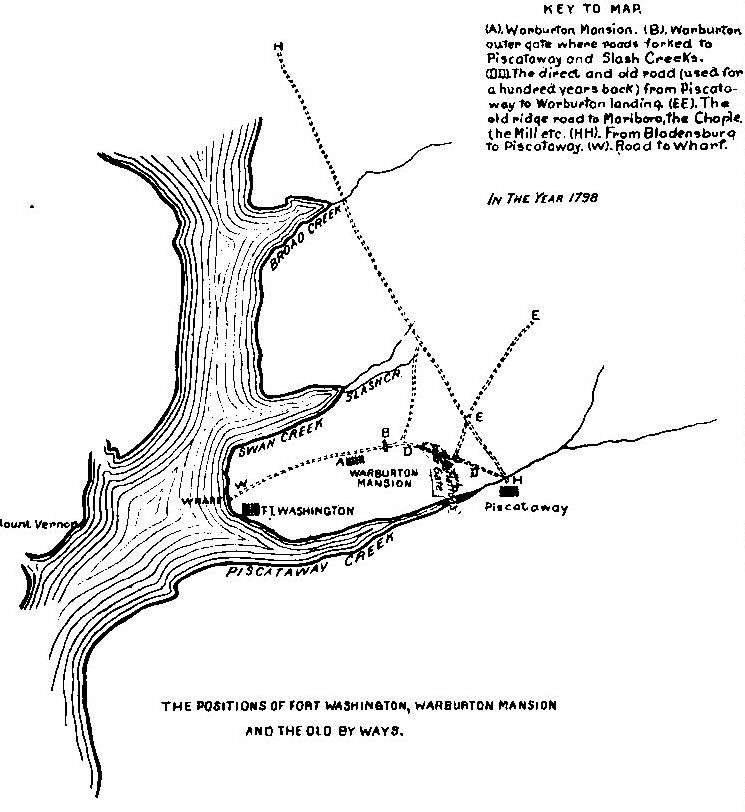
Warburton Mansion and the Old
By-Ways in 1798
Exhibit 7
On Monday 19th to be Sent to
Major L'Enfant at Fort Washington, 50 Men with 15 or 20
Wheelbarrows, Spade & pick axe & a Number of Good Axes.
Carts will be Wanted hereafter.
Timber will Also be Wanted for the Work And Some
Carpenters & Masons & About 20000 Bricks. Some rough
Stone & lime, of Which a note will be given by Major L
'Enfant.
Signed Jas. Monroe
Sept. 15th, 1814.
Major Marsteller
Materials Ordered from 500 to 1000 perch Stone
from 1 to 200000 Bricks
Timber 40 feet long- 14 Inches square- 30 pieces
Scantling 30 feet long - 6 by 9- 400 pieces
Plank 25 feet long - 3 or 4- about 5000 feet
1 Gin Complete with falls. |
Captain
Gordon, H. M. S. Seahorse, commanding the Potomac squadron, in
his report has this to say of that part of the journey in the
vicinity of Mount Vernon and Fort Washington:
''The following morning, August 27,
1814, to our great joy the wind became fair, and we made all
sail up the river, which now assumed a more pleasing aspect. At
five o'clock in the afternoon. Mount Vernon, the retreat of the
illustrious Washington, opened to our view, and showed us for
the first time, since we entered the Potomac, a gentleman's
residence.
Higher, up the river on the opposite
side Fort Washington appeared to our anxious eyes, and to our
great satisfaction, it was considered assailable. A little
before sunset the squadron anchored just out of the gunshot; the
bomb vessels at once took up their positions to cover the
frigates in the projected attack at daylight next morning and
began throwing shells. The garrison, to our great surprise,
retreated from the fort; and a short time afterwards. Fort
Washington was blown up, which left the capital of America and
the populous town of Alexandria open to the squadron, without a
loss of a man. It was too late to ascertain whether this
catastrophe was occasioned by one of our shells, or whether it
had been blown up by the garrison; but the opinion was in favor
of the latter. Still we are at a loss to account for such an
extraordinary step. The position was good, and its capture would
have cost us at least fifty men and more, had it been properly
defended; besides an unfavorable wind and many other chances
were in their favor, and we could have only destroyed it had we
succeeded in the attempt.
''At daylight the ships moored under
the battery and completed its destruction. The guns were spiked
by the enemy; we otherwise mutilated them, and destroyed the
carriages. Fort Washington was a most respectable defense; it
mounted two fifty-two pounders, two thirty-two pounders, eight
twenty-four pounders; in a martello tower two twelve-pounders,
with two loop-holes for musketry; and a battery in the rear
mounting two twelve and six six-pound field pieces.''
There can be no doubt that had Fort
Washington been properly garrisoned and the channel obstructed,
as General Winder requested (August 19, 1814), and suitable
batteries erected at the proper time on the river, the British
squadron would never have reached Alexandria. The officer
(Exhibit 8) who had run away with his command from Fort
Washington was tried by the court-martial and dismissed from the
service.
Exhibit 8
Adt. & Inspr. Genl's Office
Washington
Oct. 13, 1814
Sir:
You will attend as a Witness on the part of the prisoner
before the Genl. Court Martial sitting in this City for
the Trial of Cap. Saml. T. Dyon (?) on Thursday the 20th
inst.
I am Sir Yr. Obt Servt
Jn p. Bell (?) Maj. Genl,
Major L 'Enfant
Engineer Fort Washington |
A letter
dated Fort Washington, July 19, 1815, from L 'Enfant to Major
Marsteller, reads as follows:
Exhibit 9
Fort Washington
July 19, 1815 Sir
With pleasure I forward to you agreeable to application
an expression of my opinion of your character and
conduct during your attendance on Fort fort [sic]
Washington. I have Sir in all things that have come
under my notice found you correct & in conduct the
perfect gentleman.
P. Ch. L 'Enfant
to Major Marsteller, etc. |
After the
second war with Great Britain, Fort Washington was allowed, as
most of the fortifications throughout the United States, to go
to rack and ruin for want of proper care to its armament and
entrenchments, until in 1850 it was a mere military post, having
one or two companies of artillery, and later on only a
detachment of the ordnance corps.
Fourth Period
In all
periods of North American history, aboriginal, revolutionary and
successional, the ground where Fort Washington stands to-day has
taken a prominent part. The first order issued during the Civil
War for the protection of Washington to the naval forces was
dated January 5, 1861, signed Isaac Toucey, Secretary of the
Navy, and addressed to Col. John Harris, Commandant Marine
Corps, directing that a force of marines be sent to Fort
Washington, down the Potomac, for the protection of public
property. Forty men, commanded by Capt. A. S. Taylor, U. S.
Marine Corps, were sent in obedience to this order.9
Historic Fort Washington, which has
seen so many vicissitudes and taken part in so many wars,
invasions, sieges and insurrections of this country, had a
garrison flag raised to the top of a new steel flag pole, on
Wednesday, December 12, 1902, with military ceremony, the music
playing, troops drawn up in line with presented arms, and a
salute being fired from the guns of the fort. The new flag,
which is a large one, flies from the top of the pole fully two
hundred feet above the river. It is so situated on a high hill
that it can be seen for miles. Until this time only a small flag
had been used at Fort Washington on the flag pole within the old
stone fort. Under the authority of the War Department the large
garrison flag has now been raised, signifying Fort Washington is
the headquarters for the Potomac forts.
Discussion
Mr. M. I.
Weller said: While the able paper which has just been read by
Dr. Morgan deserves abundant praise, still I cannot allow this
occasion to pass without entering my protest against the
undeserved condemnation of the American army which was entrusted
with the defense of the National Capital and which was commanded
by that efficient soldier, General William H. Winder, who with
the hastily gathered forces made a determined defense against
Wellington's veterans fresh from the scenes of victories in the
Napoleonic wars under the leadership of General Ross who had
enjoyed a reputation second to none; I certainly believe at this
late day no historian who will have access to original sources
will repeat the slurs that were so prevalent shortly after the
disaster and which forced the Secretary of War, General
Armstrong, into retirement, the victim of public clamor; the
campaign lasted ten days with its culmination at Bladensburg,
where the forces engaged were nearly equal in number; the battle
was well contested, especially by the District of Columbia
contingent, numbering about 1,100 men, under the command of
General Walter Smith, and the sailors of Commander Barney's
flotilla, who served their guns with admirable precision until
their ammunition was exhausted ; the statement that the army was
panic-stricken so often mentioned is not based on facts, there
was no rout, but the retreat was effected in an orderly manner,
although some of the guns had to be abandoned; it is said that
when the order was given to retreat, the District contingent was
reluctant to leave the field and some even shed tears that they
should be compelled to retire; of course the defeat left the
road to Washington open, and the enemy entered the city, on
their mission of destruction, reaching Capitol Hill about eight
o 'clock P. M.; the main cause of the British victory was the
use of Congreve rockets, missiles of war totally unknown on this
side of the Atlantic and which had spread consternation in the
ranks of the French veterans at the battle of Leipsic, a year
previous; and which had the tendency to demoralize any troops
unacquainted with this naval implement of war; the British
forces fled precipitately from the city the following night,
after indulging in acts of vandalism disgraceful to England and
subsequently condemned by the civilized world; the British
casualties were over 1,100 in number, more than one fourth of
their total army, and in their retreat they abandoned their
wounded to the mercy of their American foe, who attended them
with such generosity" that it enlisted the grateful
acknowledgments of General Ross and Admiral Cockburn; this at
least is one of the bright redeeming features of this short
campaign and in vivid contrast to the unjustifiable deeds
perpetrated by their enemies; as a grandson of one of the
British invaders (my maternal grandfather was an officer in the
44th foot), I am happy to be able to pay this tribute to
American valor and American humanity; doubtless many mistakes
were made, errors of judgment prevailed in disregarding the
warning that the Capital might be attacked, but the charges of
cowardice against the American army will not be successfully
maintained by any historian who dispassionately reviews all
occurrences leading up to that fatal August 24, 1814, and who
has a due regard for American honor.
Miss Elizabeth Johnston said that the
massacre of the Susquehannock Indians is referred to as
occurring in the neighborhood of Piscataway Creek. The chief of
the Piscataways was, as the essayist noted, spoken of as ''the
emperor.''
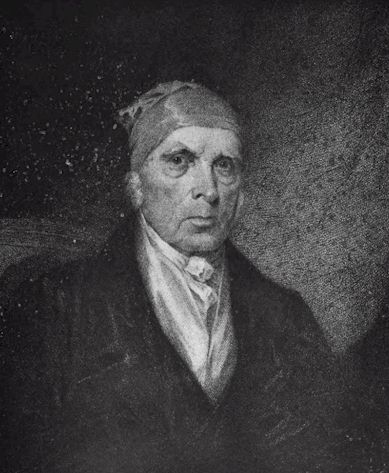
James Madison
General B. K. Roberts, commanding the
defenses of the Potomac with headquarters at Fort Washington,
said that with the present armament of the fort it would be an
easy matter to sweep the Potomac for miles downstream. Owing, he
said, to the elevation of Fort Washington, as well as the
batteries on the Virginia side, above water level, the force at
this point in the event a hostile fleet came up stream, would be
able to pour in a raking fire on the decks of the enemy's ship,
which constitute the weakest portion of modem war ships.
Footnotes:
1.
Marlborough Point was on Potomac Creek; and here as early as
1828, the steamer from Washington made connections with the
stage for southern and southwestern travel: "Time between
Washington and Richmond is 20 hour a, being 24 hours sooner than
by any other route.
2. McSherry's
"History of Maryland.
3. Bozman's "History of Maryland," vol. 2, p.
291.
4. 12th of May, 1704, Henry Knox, who was
Secretary of War under President Washington received a letter
which reads thus: The President of the United States who is well
acquainted with the river Potomac conceived that a certain bluff
of land on the Maryland side, near Mr. Digges', a point formed
by an eastern branch of the Potomac would be a proper situation
for the fortification about to be erected." The amount to be
expended for the fort was only to be $3,000.
5. "The troops stationed near Fort Washington
(Warburton)." National Intelligencer, July 20, 1813.
6. Social Life in the Early Republic," Wharton.
7. Original of Exhibits 1, 3 and 4 in Department
of State, Washington, D. C.
8. The British passed the kettle bottoms on the
ascent of the Potomac August 19 and reached Alexandria August
27. The kettle bottoms of the Potomac River are bars of mud and
oysters more frequently found between Lower Cedar Point and Cob
Point Lighthouse, a distance of about six miles.
9. Richard Wainwright, U. S. N.
AHGP
District of Columbia

Source: Records of the Columbia Historical Society, Washington
DC, Committee on Publication and the Recording Secretary, Volume
7, Washington, Published b the Society, 1904.
|

![]()

![]()

